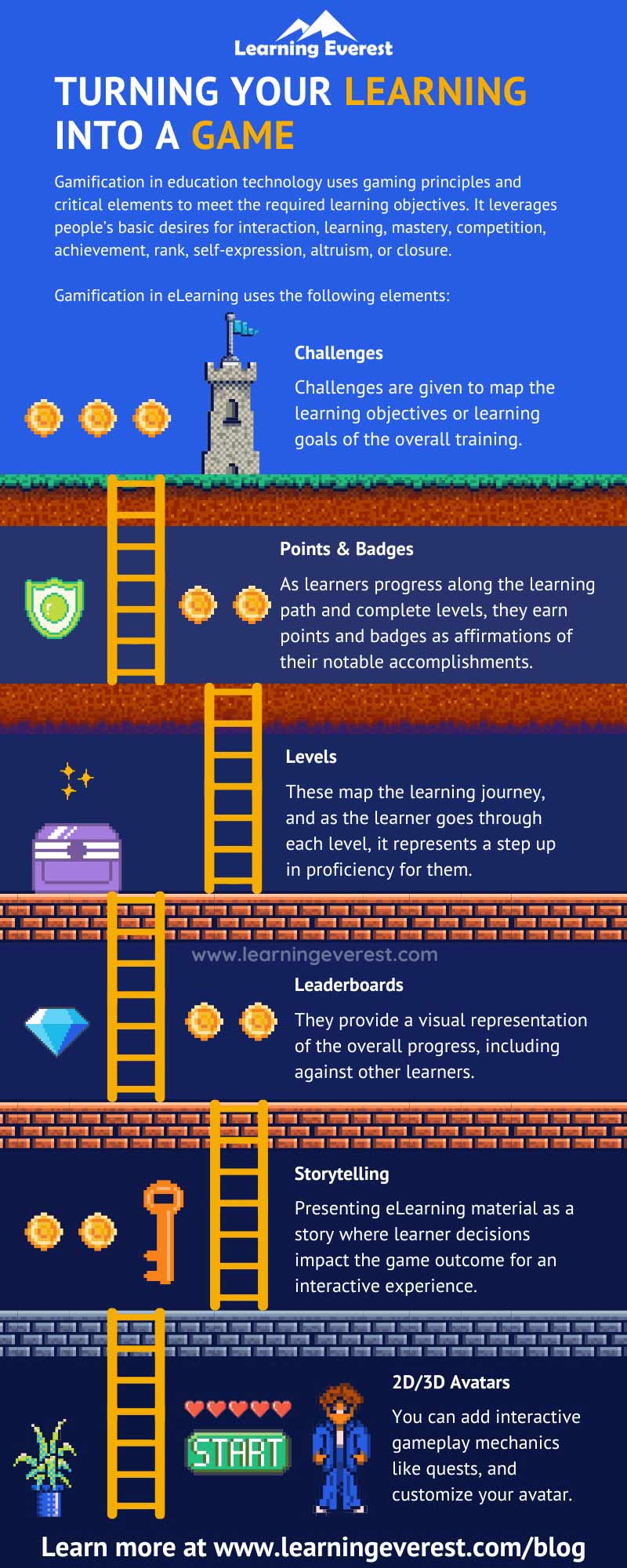What is Gamification in Educational Technology?
Gamification in Educational Technology (EdTech) is the application of game principles to the learning process and ecosystem to motivate learners. Gamification taps into people’s basic desires for interaction, learning, mastery, competition, achievement, ranking, self-expression, altruism, or completion. Gamification engages players by rewarding them for completing a desired task or competition. Types of rewards include:
- point,
- badge,
- Leaderboards,
- assignment,
- level,
- A progress bar, or
- It provides virtual currency to players.
Encourage competition by making task achievements visible to other players and providing leaderboards.
Here’s why gamification is important in educational technology:
1 – Increase learner engagement
Traditional teaching methods often struggle to keep learners engaged, leading to passive learning and apathy. But not with gamification.
reason?
- Gamification introduces a dynamic layer to the educational experience, making learning activities more engaging.
- Points systems, leaderboards and badges provide visible recognition of achievements and motivate learners to engage further with the content.
In an age where distractions are plentiful and sustained attention is at a premium, this increased engagement is crucial.
2 – Encourage healthy competition among learners
The essence of gamification is to address the motivational challenges many learners face. Game elements such as a) points, b) badges, and c) leaderboards tap into the natural human desire for competition and achievement. When learners see tangible rewards for their efforts, it stimulates intrinsic motivation, creating a positive feedback loop. For example, learners may be more engaged if they can earn badges or progress to new levels by working on additional math problems, similar to achievements in video games.
3 – It helps you customize the learning experience for your learners
Gamification enables personalized learning paths in diverse classrooms where learners have diverse skills and interests, so each learner experiences a journey that is tailored to their unique needs and pace, reducing frustration and improving learning outcomes. This personalization makes learning more relevant and effective, improving academic performance.
4 – Promote social interaction among learners
Many gamified learning platforms incorporate social elements such as teamwork and collaboration. These features mimic the social dynamics of multiplayer games and encourage learners to work together to solve problems or compete with other teams. Not only does this make learning more fun, it also helps develop important soft skills such as communication, leadership, and teamwork. In a world that increasingly values collaboration, integrating these skills early through educational technology is a huge advantage.
5 – Provide learners with immediate feedback
Traditional teaching methods often result in delayed feedback. In this scenario, learners have to wait days, or even weeks, to receive their grades or corrections. Gamification allows for instant feedback, which is critical for effective learning. Instant feedback allows learners to immediately understand what they know and what they need to improve. This allows for a more iterative learning process. This immediate responsiveness allows learners to adjust their learning strategies in real time. This results in a more efficient and responsive educational experience.
Examples of Gamification in Educational Technology
Gamification in educational technology can increase learner engagement and retention, making training programs more effective. Here are some examples:
Example 1 – Competitive games
Competitive games are games in which players or teams compete against each other to achieve a specific goal. They’re a fun way to challenge yourself and hone your skills. But remember to play fair and demonstrate good sportsmanship. Feedback should also be good. Creating competitive games can help learners master target skills and apply that knowledge in the real world.
Example 2 – Scenario-based games
In scenario-based games, the player is presented with a scenario or situation and must make decisions based on that scenario. These games can be educational or entertainment, and the player’s decisions determine the outcome of the game, making it an interactive and immersive experience. Examples of scenario-based games include:
- Role-playing games,
- Simulation games and
- A choose your own adventure game.
Scenario-based games allow learners to think and act in the most logical way in a virtual environment, and advances in VR and AR technology make such games more accessible, providing opportunities for learners with different learning needs and preferences.
Example 3 – 2D/3D avatar-based game
In 2D/3D avatar-based games, players create and control a character or avatar in a virtual fictional world. These games feature social interactions and gameplay mechanics such as quests, battles, and avatar customization options. These games are becoming increasingly important in the field of educational technology by providing immersive and interactive learning experiences, which add a personalized touch to the educational process. The goal is to create an educational experience that is not only informative but also engaging; keeping learners motivated and interested throughout their learning journey.
Example 4 – Mind Mapping Game
Mind mapping games are a fun and creative way to train your brainstorming skills and improve your memory. These games allow you to visually organize your thoughts, ideas and concepts in a non-linear way. You can easily see the connections and patterns between them. Whether you want to increase your productivity, enhance your creativity or just have fun, mind mapping games are a great way to achieve your goals. Just map out new ideas, explore concepts and activate your brainstorming sessions.
Example 5 – Decision Game
Decision-making games require players to make choices that affect the outcome of the game. These games are a great way to train critical thinking skills and are a fun and immersive way to spend time. Hence, adding these games to your eLearning allows learners to make decisions individually or as a team. Team thinking games transform learners into influential decision-makers and communicators.
Additionally, interactive dashboards allow you to analyze the effectiveness of activities and evaluate learner performance. Features such as leaderboards, scores, badges, and other rewards can be embedded into game-based learning modules to provide better learning outcomes.
What’s next…
In conclusion, gamification is promising, but more research is needed to support its long-term benefits for educational purposes. That said, gamification in educational technology is a growing field that has the potential to change the way learners learn by making learning more interactive and fun. As gamification continues to evolve, it will be important to conduct systematic studies and rigorously test approaches to confirm its educational benefits.
Was this article helpful?
The following articles can also be a helpful guide to help you get started:
Or talk to us about creating engaging and innovative gamification in educational technology for your learners. Schedule a demo today.
Infographic

The Importance of Gamification in Educational Technology Infographic
Knowledge check!
Frequently Asked Questions (FAQ)
Q: What is gamification?
A: Gamification in educational technology (EdTech) is the application of game principles to the learning process and its ecosystem to motivate learners.
Q: What are some examples of gamification?
A: Here are some examples of gamification:
- Competitive games
- Scenario-based games
- 2D/3D avatar-based games
- Mind Mapping Games
- Decision-making games
Q: Why is gamification important in educational technology?
A: Gamification introduces a dynamic layer to the educational experience, making learning activities more engaging. This increased engagement is crucial in an age where distractions are abundant and sustained attention is at a premium.
